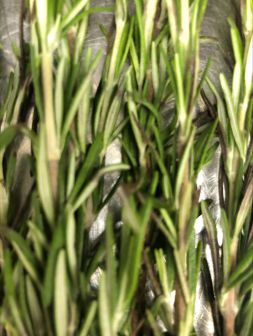The medicinal herb known as rosemary belongs to the Lamiaceae family. It is called "rozmarini," "lasmari," "arismares," "dentrolivano," or "dyosmarini," but it is most fittingly referred to as the "prince of aromatic plants," as it was known in the past. It is also called the "dew of the sea" due to its habit of growing near the sea.
Rosemary is an evergreen shrub with many branches, densely packed small linear leaves that are green on top and white underneath. Its flowers are pale blue-white. It is a wild plant found in almost all of Greece, particularly in rocky areas.
It can be propagated by allowing cuttings to develop roots or by growing from seeds (which often sprout). It is cultivated for commercial purposes in southern Europe.
Rosemary blooms in spring and summer. Ancient Greeks believed it to be a brain tonic. Young students used to wear garlands of rosemary around their necks or weave branches into their hair during exams to stimulate their memory. In the rituals of ancient people, it symbolized marriage, love, and death. When young girls got married, they adorned their heads with rosemary wreaths. Rosemary is one of the plants used in our church's blessings.
Rosemary contains tannins and essential oil, which are used in perfumery. Mixed with wine, its flowers create a good cardiac tonic and improve vision. It is generally used for insomnia, fainting, and dizziness. It is believed to purify the blood and is beneficial for respiratory problems and asthma. It is also stomachic, tonic, antiseptic, and antispasmodic. Applied through rinses or baths, it is beneficial for the skin, promotes hair growth, and combats diabetes. Its infusion is used for washing infected wounds. It uplifts the mood and is useful in cases of mild to moderate depression. It is also used as a seasoning, although rarely to increase appetite. In cooking, it is used in sauces, marinades, meats, fish, olive oil, vinegars, and more. It combines well with citrus fruits in baking. It imparts intensity of aroma and flavor. It can be found in traditional recipes such as snails "boubouristi," fried liver, fruit salads, soups, seafood, cheeses, game dishes, and more.
LATEST RECIPES
GET LATEST UPDATES
Newsletter Subscribe
FEATURED ARTICLE

GET LATEST UPDATES
Newsletter Subscribe























































































